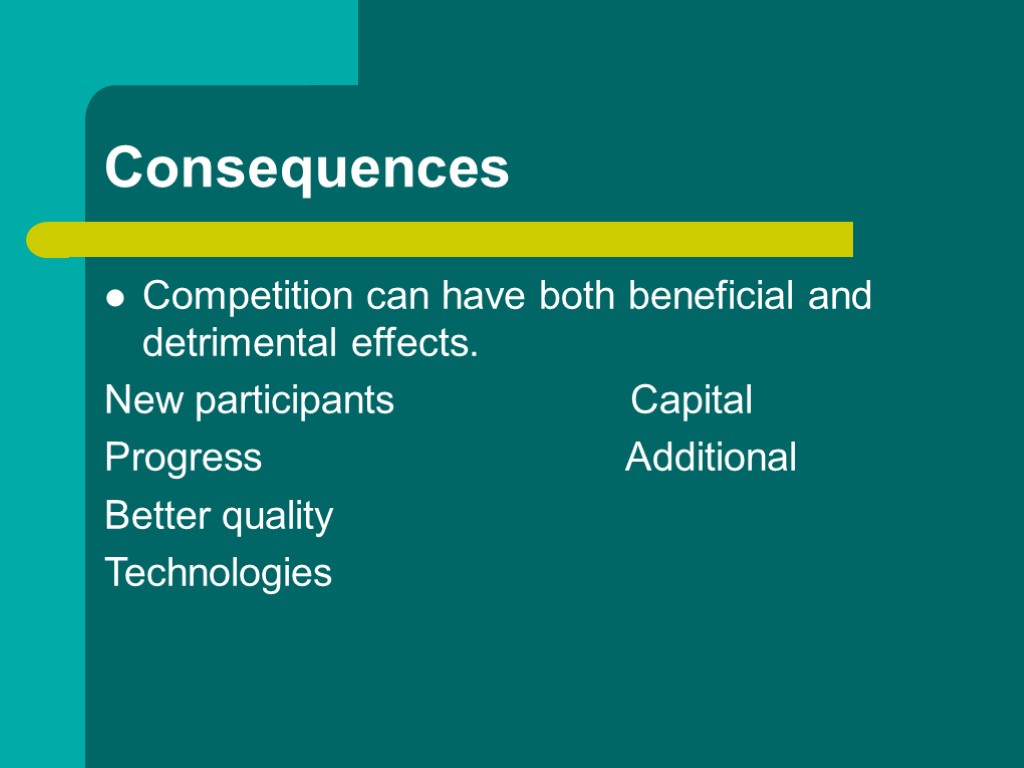BASIC ECONOMIC TERMINOLOGY Competition. Types of markets. Supply


BASIC ECONOMIC TERMINOLOGY Competition. Types of markets. Supply and Demand.

DEGREES OF COMPETITION Competition is a contest between individuals, groups, nations, companies, etc. for territory, a niche, or a location of resources. It arises whenever two or more parties strive for a goal which cannot be shared Business is often associated with competition as most companies are in competition with at least one other firm over the same group of customers.

Pure Competition low barriers to entry, many choices, no business has dominancesdc - many companies competing and nobody has a significant advantage examples small bars and restaurants variety stores, convenience stores nail salons, barbers small grocery stores doughnut shops professional services (dentist, doctor, architects)

Oligopoly - very similar products, few sellers, small firms follow lead of big firms, fairly inelastic demand sdc - many barriers to establishing a business so only the oldest and biggest businesses are operating examples - all the businesses are big and of equal size banking industry automotive manufacturers gasoline retail companies insurance companies telecommunications companies

Monopolistic Competition - sellers feel they do have some competition sdc - there is one big company dominating the market with a few medium or smaller sized companies examples Google (there used to be "pure competition" until Google grew very big and became dominant) Walmart

Consequences Competition can have both beneficial and detrimental effects. New participants Capital Progress Additional Better quality Technologies

Types of markets Financial markets facilitate the exchange of liquid assets. Most investors prefer investing in two markets, the stock markets and the bond markets. NYSE, AMEX, and the NASDAQ are the most common stock markets in the US. Futures markets, where contracts are exchanged regarding the future delivery of goods are often an outgrowth of general commodity markets. Currency markets are used to trade one currency for another, and are often used for speculation on currency exchange rates. The money market is the name for the global market for lending and borrowing. A black market is one where the buying and selling of products and services take place in an illegal manner. A grey market involves the buying and selling of goods and services that are not illegal, but the channels used in their distribution are either unauthorized or unofficial. Free market is a market where demand and supply of product is not controlled by govt. or any other authority

SUPPLY AND DEMAND Supply and demand is an economic model of price determination in a market. It concludes that in a competitive market, the unit price for a particular good will vary until it settles at a point where the quantity demanded by consumers (at current price) will equal the quantity supplied by producers (at current price), resulting in an economic equilibrium of price and quantity.

The four basic laws of supply and demand are: If demand increases and supply remains unchanged, then it leads to higher equilibrium price and quantity. If demand decreases and supply remains unchanged, then it leads to lower equilibrium price and quantity. If supply increases and demand remains unchanged, then it leads to lower equilibrium price and higher quantity. If supply decreases and demand remains unchanged, then it leads to higher price and lower quantity.

Equilibrium Equilibrium is defined to the price-quantity pair where the quantity demanded is equal to the quantity supplied, represented by the intersection of the demand and supply curves. Market Equilibrium: A situation in a market when the price is such that the quantity that consumers wish to demand is correctly balanced by the quantity that firms wish to supply. Comparative static analysis: Examines the likely effect on the equilibrium of a change in the external conditions affecting the market.

Elasticity Elasticity refers to how strongly the quantities supplied and demanded respond to various factors, including price and other determinants. Elasticity is calculated as the percentage change in quantity divided by the associated percentage change in price.
basic_economic_terminology-1.ppt
- Количество слайдов: 11

